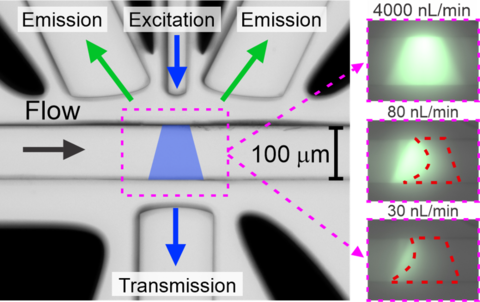Summary
Current work, within the NIST on a Chip Program, includes developing microfluidic systems that improve the accuracy of flow measurements, which are fundamental to validating and maintaining the performance of microfluidic systems. The lab is creating new devices and measurement techniques to characterize very small flows in microfluidic/Lab-on-a-chip systems. The project goal is to use a novel approach involving an integrated microfluidic and optical system to improve by more than 10-fold the resolution of micro- and nanoscale liquid flow measurements and to develop novel methods to determine zero flow (e.g. distinguish between convective and diffusive transport).
Description

Ultra-precise and dynamic flow measurements are needed for high-throughput biological studies and for dynamic control of chemical delivery systems in medical and biotechnology applications. In addition, existing analytical methods, such as analytical high-performance liquid chromatography (HPLC) and flow cytometry would be improved with more accurate flow measurements.
We recently demonstrated an optofluidic flow meter that improves upon real-time measurement of nanoflows by at least an order of magnitude over conventional methods, with another order of magnitude improvement expected from simple engineering modifications.
Our method incorporates optical waveguides to deliver excitation and collect emitted light from fluorophore dyes as they cross a laser path. Our system utilizes the bleaching of dyes as they receive a dosage of light crossing the excitation light. The dosage relationship allows us to generate a scalable relationship between emitted fluorescence as a function of the combined effect of laser power and dwell time (inverse flow rate) of the dyes in the light excitation region. The scaling relationship is then used to expand the range of a calibrated flow measurement to a region well below the calibrated range without increasing the relative uncertainty of the flow measurement.
Major Accomplishments
Using microfluidic devices with integrated optical waveguides, we recently achieved dynamic measurements of 10 nL/min to within 5% uncertainty. We also have determined the uncertainty of zero flow to better than 0.2 nL/min, which is effectively the resolution between advection and diffusion (Cooksey et al. 2019). Additional improvements in accuracy, dynamic range, and temporal resolution are ongoing.

